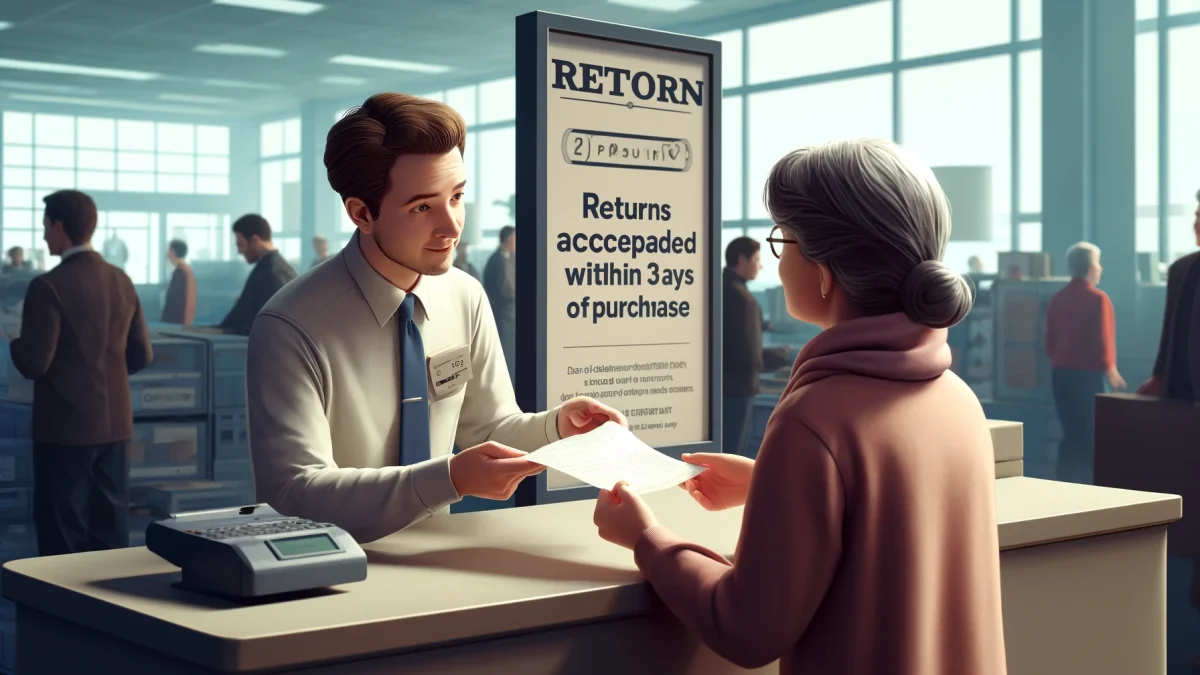Question: You bought an item at a department store and want to return it. However, the store’s return policy states that returns are only accepted within 30 days of purchase. If the 30-day period has expired, how should you proceed?
a) Assume that it is impossible to return the item since the period has expired.
b) Offer to exchange the item.
c) Consider the return impossible because you do not have the receipt.
d) Consult with the store manager to request an exception for the return or exchange.
質問: 百貨店で商品を購入しましたが、返品したいと考えています。しかし、店舗の返品ポリシーによると、購入から30日以内の返品のみ受け付けるとされています。購入日から30日を過ぎていた場合、どのように対応すべきでしょうか?
選択肢:
a) 期限が過ぎているため、返品は不可能であると考える。
b) 商品の交換を申し出る。
c) レシートがないため、返品はできない。
d) ストアマネージャーに相談し、返品や交換についての例外対応を依頼する。
解説:
- 選択肢d(ストアマネージャーに相談し、返品や交換についての例外対応を依頼する)は、ポリシーの例外を認めてもらう可能性を探る最も実用的な選択肢です。管理者は場合によっては規則を柔軟に適用する権限を持っているため、直接相談することが解決への道を開く可能性があります。
- 選択肢a(期限が過ぎているため、返品は不可能であると考える)は、返品ポリシーをそのまま受け入れ、他の解決策を探求しない受動的なアプローチです。返品が完全に不可能であるわけではなく、時には例外が許される場合もあるため、最善の選択とは言えません。
- 選択肢b(商品の交換を申し出る)も一考の価値はありますが、返品ポリシーが30日を超えた返品や交換を認めていない限り、この選択肢も同じ問題に直面します。ポリシーの詳細にも依存しますが、単独で最良の選択とは言えないでしょう。
- 選択肢c(レシートがないため、返品はできない)は、レシートの有無が問題の主題ではなく、返品期限に関するものであるため、このシナリオでは不適切です。レシートがなくても、店側が取引の記録を持っている場合があるため、必ずしも返品が不可能とは限りません。
以上から、選択肢dが最も積極的で問題解決に直結するアプローチを提供しているため、この問題に対する最適な答えと言えるでしょう。他の選択肢は解決に直接結びつかないか、事態を受け入れるだけの受動的なものになっています。
Explanation:
- Option d (Consult with the store manager to request an exception for the return or exchange) is the most practical choice as it explores the possibility of an exception being granted. Managers sometimes have the authority to apply rules flexibly, so speaking directly could potentially open a path to resolution.
- Option a (Assume that it is impossible to return the item since the period has expired) is a passive approach that accepts the return policy as is, without seeking other solutions. It is not the best choice because returns are not completely impossible, and exceptions may sometimes be granted.
- Option b (Offer to exchange the item) might be worth considering, but it faces the same issue if the return policy does not allow exchanges or returns past 30 days. This choice depends on the specifics of the policy and is not the best option on its own.
- Option c (Consider the return impossible because you do not have the receipt) is inappropriate for this scenario because the main issue is the return period, not the presence of a receipt. Even without a receipt, the store might have records of the transaction, so returns are not necessarily impossible.
Therefore, option d provides the most proactive and direct approach to solving the problem, making it the best answer for this question. The other options either do not directly lead to a solution or represent a passive acceptance of the situation.
問題2: You are shopping at a grocery store and notice a sign that says, “Buy 2, Get 1 Free” for a specific product. What does this offer imply?
a) Purchasing one item at regular price.
b) Paying twice the price for three items.
c) Receiving a free item with the purchase of two.
d) Receiving a discount on the total purchase.
この問題は、特定の商品について「2つ購入すると1つ無料」というサインを見かけた場合の意味を尋ねています。正解は「c) 2つ購入すると1つ無料」となります。このオファーは、2つの商品を購入すると1つ無料で提供されることを意味します。これは、2つ目の商品を通常価格で購入し、3つ目の商品が無料で提供されるということです。不正解の選択肢について: a) 1つの商品を通常価格で購入するという選択肢は、オファーが提供する内容と一致しません。オファーは2つの商品の購入に対して1つ無料で提供されるものです。 b) 3つの商品を2倍の価格で購入するという選択肢も、オファーが提供する内容と一致しません。オファーは2つの商品の購入に対して1つ無料で提供されるものです。 d) 合計購入額に割引が適用されるという選択肢も、オファーが提供する内容と一致しません。オファーは特定の商品の購入に対して1つ無料で提供されるものです。
This problem asks about the meaning of seeing a sign that says “Buy 2, Get 1 Free” for a specific product. The correct answer is “c) Receiving a free item with the purchase of two.” This offer implies that when you buy two items, one item is provided for free. It means buying the second item at the regular price and getting the third item for free. As for the incorrect options:
a) Choosing to buy one item at the regular price does not align with what the offer entails. The offer provides one item for free with the purchase of two.
b) Purchasing three items at twice the price is also not in line with what the offer provides. The offer gives one item for free with the purchase of two.
d) The choice stating that a discount is applied to the total purchase does not match what the offer provides. The offer entails receiving one item for free with the purchase of a specific product.

